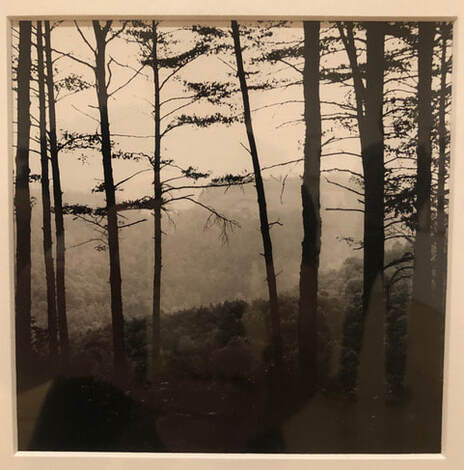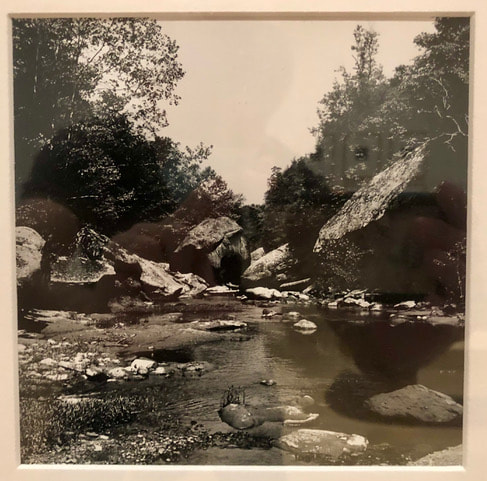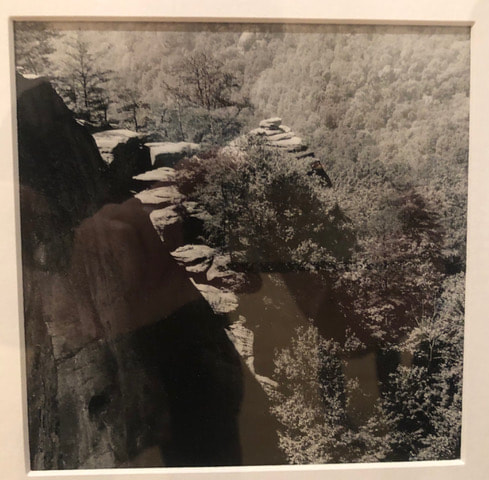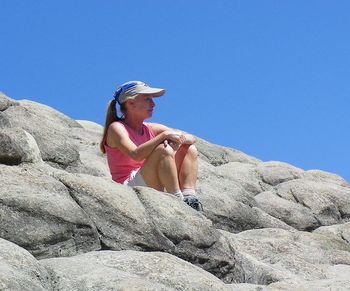 Photograph by Ralph Eugene Meatyard (1925–1972) from “The Unforeseen Wilderness,” 1967–1971, as currently exhibited at the Speed Art Museum, Louisville, Ky. ©The Estate of Ralph Eugene Meatyard. Images of exhibited artwork captured by David Hoefer. Photograph by Ralph Eugene Meatyard (1925–1972) from “The Unforeseen Wilderness,” 1967–1971, as currently exhibited at the Speed Art Museum, Louisville, Ky. ©The Estate of Ralph Eugene Meatyard. Images of exhibited artwork captured by David Hoefer. David Hoefer of Louisville, Ky., the co-editor of The Last Resort, reminds us of the power of art. If you would like to submit a post to Clearing the Fog, please contact us here. The late 1960s and early 1970s saw the emergence of environmentalism as a significant element in the political wrangling of the day. Kentucky old-timers likely remember one of the pivotal episodes in that emergence: the battle over damming the Red River and what would have been the wholesale alterations to landscape and ecology resulting from infrastructure of that magnitude. The Army Corp of Engineers and many local residents lined up on one side; the Sierra Club, environmentalists, and various culture warriors lined up on the other. Each alliance had serious points in its favor. Ultimately, with the scrapping of construction plans, the environmentalists won out. The gorge is now protected by inclusion in federal programs for natural, historic, and archaeological settings. I bring this up because the J. B. Speed Art Museum in Louisville is currently hosting an exhibit that was directly inspired by the battle over Red River Gorge. One of the dam’s chief opponents was Kentucky author Wendell Berry. Berry coauthored a book, The Unforeseen Wilderness, with another native artist, the Lexington photographer Ralph Eugene Meatyard. It is Meatyard’s photographs from this collaboration that are on display, and which allow us to reenter that time and place in history. The Unforeseen Wilderness is undoubtedly the most important document for the defense of the ecological and spiritual qualities of a unique landscape to emerge from the conflict. (I suppose the other side could point to the dam’s architectural plans and, no, I’m not being facetious. Good engineering is to be admired.) Meatyard and Berry worked separately and together to produce their dual vision for preserving the gorge. Berry uses words, so he carries the weight of argument, which is sometimes cranky and polemical. Meatyard uses shadow and light, which means that he comes closer to presenting the gorge as it is, or was, within the limitations of photographic technology and one man’s subjective response to the world in front of him. The great variety of settings at Red River, the many microclimates and eco-niches, becomes immediately apparent in Meatyard’s camerawork, which is amply attested to in the book and the exhibit. That diversity bounding on the infinite may be the best case for leaving the flood-prone gorge in its (more or less) natural state. My wife and I noted the darkness of many of the photographs. Some of this was attributable to museum lighting, but the darkness was also a conscious decision by the artist, either in camera settings or darkroom procedure (or both). Berry addresses this facet of Meatyard’s work in his foreword to a revised and expanded edition of The Unforeseen Wilderness, published after the photographer’s death from cancer: “As I look now at [Meatyard’s] Red River photographs, I am impressed as never before by their darkness. In some of the pictures this darkness is conventional enough. It is shadow thrown by light; we see the lighted tree or stone and we see its cast shadow. In other pictures the darkness is not shadow at all. It is the darkness that precedes light and somehow includes it; it is the darkness of elemental mystery, the original condition in which light occurs…The darkness of these pictures is an imagined darkness; and this was a courageous imagining, for the darkness is made absolute in order to make visible the smallest lights, the least shinings and reflections. Sometimes the lights require hard looking to be seen” (1991:xi-xii). Here we’re edging into the metaphysical. Maybe Meatyard’s Red River Gorge is more art than nature after all. The Meatyard exhibit is showing at the Speed until February 13, 2022. I’ve included a few photographs of the photographs as enticement. (Just think about how much better the originals will be in person.) Click here for more information on this intriguing backward look to the early days of the environmental wars.
4 Comments
Joe Anthony
9/21/2021 04:07:51 pm
Beautiful photos. And today's Herald had a good news story: the removal of the Green River dam in Butler County, opening up the river and the land.
Reply
Sallie Showalter
9/22/2021 04:01:04 pm
Here's the article about the Green River dam: https://www.kentucky.com/news/state/kentucky/article254374638.html
Reply
Bob Patrick
9/22/2021 01:18:43 pm
There was an interesting story on WEKU recently on the recent efforts to preserve rock climbing opportunities in the gorge.
Reply
Sallie Showalter
9/22/2021 04:41:54 pm
I don't believe I found the WEKU piece you are referencing, Bob, but here are a couple of other recent reports on similar topics:
Reply
Your comment will be posted after it is approved.
Leave a Reply. |
Details
Archives
June 2023
Categories
All
|




 RSS Feed
RSS Feed